2002 MERCEDES-BENZ G500 engine
[x] Cancel search: enginePage 238 of 385
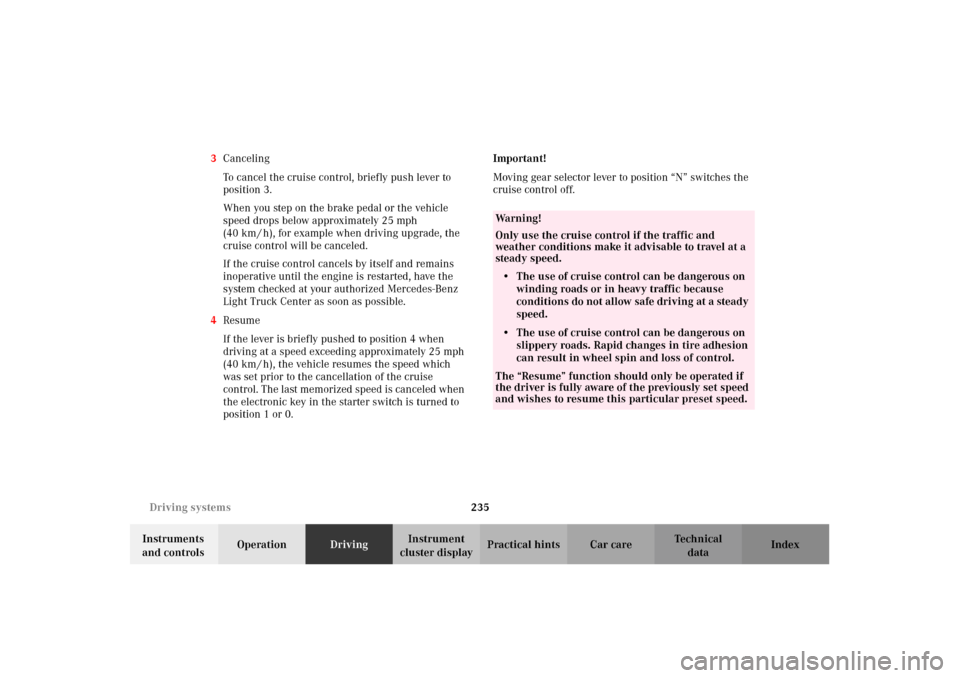
235 Driving systems
Te ch n i c a l
data Instruments
and controlsOperationDrivingInstrument
cluster displayPractical hints Car care Index 3Canceling
To cancel the cruise control, briefly push lever to
position 3.
When you step on the brake pedal or the vehicle
speed drops below approximately 25 mph
(40 km / h), for example when driving upgrade, the
cruise control will be canceled.
If the cruise control cancels by itself and remains
inoperative until the engine is restarted, have the
system checked at your authorized Mercedes-Benz
Light Truck Center as soon as possible.
4Resume
If the lever is briefly pushed to position 4 when
driving at a speed exceeding approximately 25 mph
(40 km / h), the vehicle resumes the speed which
was set prior to the cancellation of the cruise
control. The last memorized speed is canceled when
the electronic key in the starter switch is turned to
position 1 or 0.Important!
Moving gear selector lever to position “N” switches the
cruise control off.
Wa r n i n g !
Only use the cruise control if the traffic and
weather conditions make it advisable to travel at a
steady speed.• The use of cruise control can be dangerous on
winding roads or in heavy traffic because
conditions do not allow safe driving at a steady
speed.
• The use of cruise control can be dangerous on
slippery roads. Rapid changes in tire adhesion
can result in wheel spin and loss of control.The “Resume” function should only be operated if
the driver is fully aware of the previously set speed
and wishes to resume this particular preset speed.
J_G463.book Seite 235 Mittwoch, 19. September 2001 8:06 08
Page 239 of 385
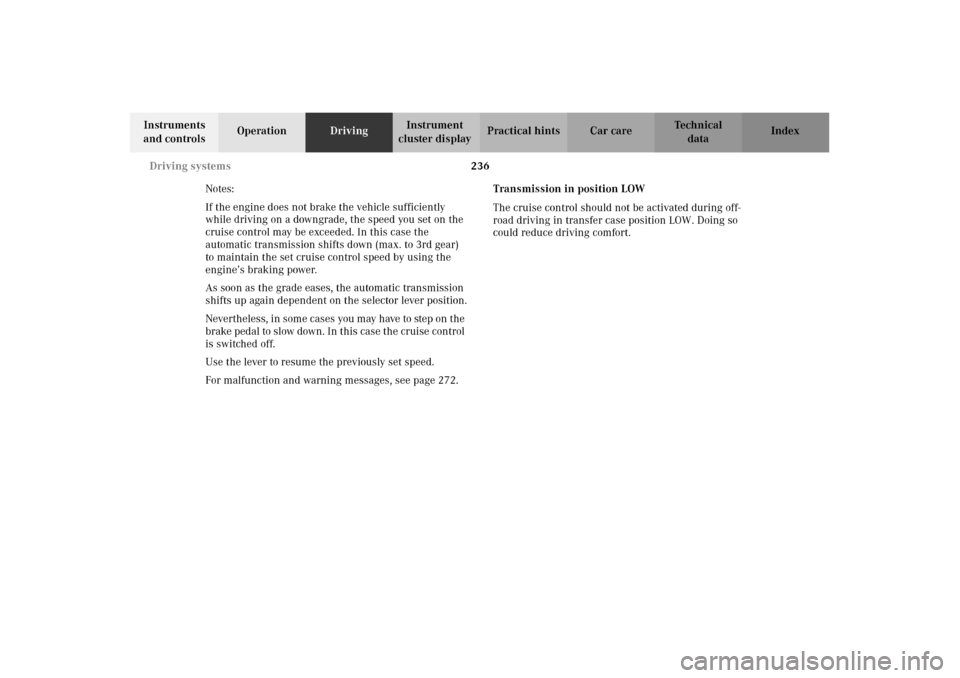
236 Driving systems
Te ch n i c a l
data Instruments
and controlsOperationDrivingInstrument
cluster displayPractical hints Car care Index
Notes:
If the engine does not brake the vehicle sufficiently
while driving on a downgrade, the speed you set on the
cruise control may be exceeded. In this case the
automatic transmission shifts down (max. to 3rd gear)
to maintain the set cruise control speed by using the
engine’s braking power.
As soon as the grade eases, the automatic transmission
shifts up again dependent on the selector lever position.
Nevertheless, in some cases you may have to step on the
brake pedal to slow down. In this case the cruise control
is switched off.
Use the lever to resume the previously set speed.
For malfunction and warning messages, see page 272.Transmission in position LOW
The cruise control should not be activated during off-
road driving in transfer case position LOW. Doing so
could reduce driving comfort.
J_G463.book Seite 236 Mittwoch, 19. September 2001 8:06 08
Page 241 of 385
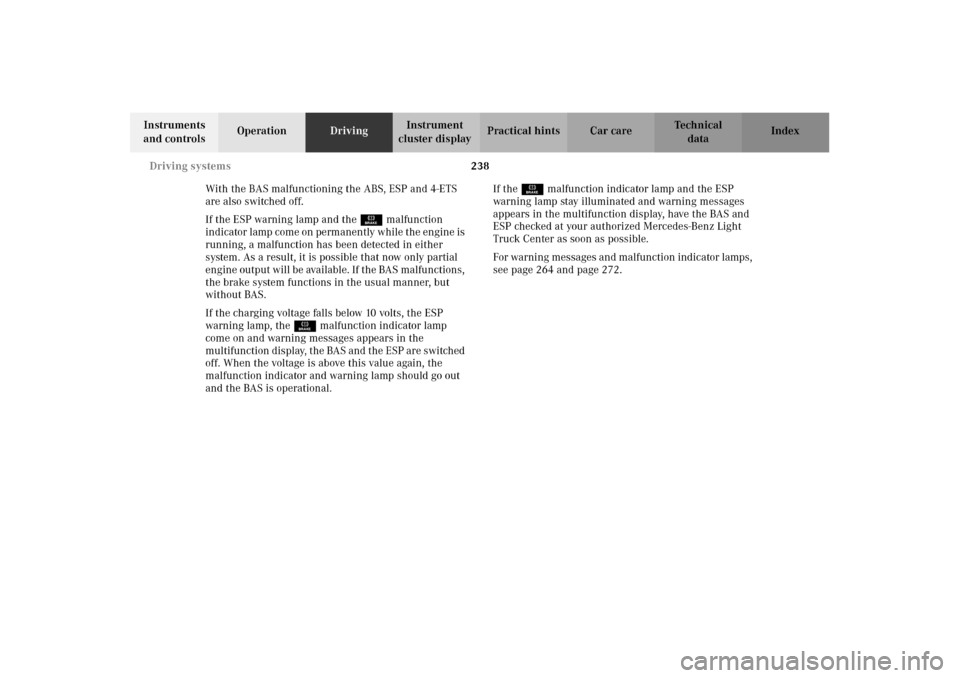
238 Driving systems
Te ch n i c a l
data Instruments
and controlsOperationDrivingInstrument
cluster displayPractical hints Car care Index
With the BAS malfunctioning the ABS, ESP and 4-ETS
are also switched off.
If the ESP warning lamp and the É malfunction
in d icator lamp c ome on pe rm anen tly while t he en gin e is
running, a malfunction has been detected in either
system. As a result, it is possible that now only partial
engine output will be available. If the BAS malfunctions,
the brake system functions in the usual manner, but
without BAS.
If the charging voltage falls below 10 volts, the ESP
warning lamp, the É malfunction indicator lamp
come on and warning messages appears in the
multif un ction d is play, t he BA S and t he E SP ar e s witched
off. When the voltage is above this value again, the
malfunction indicator and warning lamp should go out
and the BAS is operational.If the É malfunction indicator lamp and the ESP
warning lamp stay illuminated and warning messages
appears in the multifunction display, have the BAS and
ESP checked at your authorized Mercedes-Benz Light
Truck Center as soon as possible.
For warning messages and malfunction indicator lamps,
see page 264 and page 272.
J_G463.book Seite 238 Mittwoch, 19. September 2001 8:06 08
Page 242 of 385
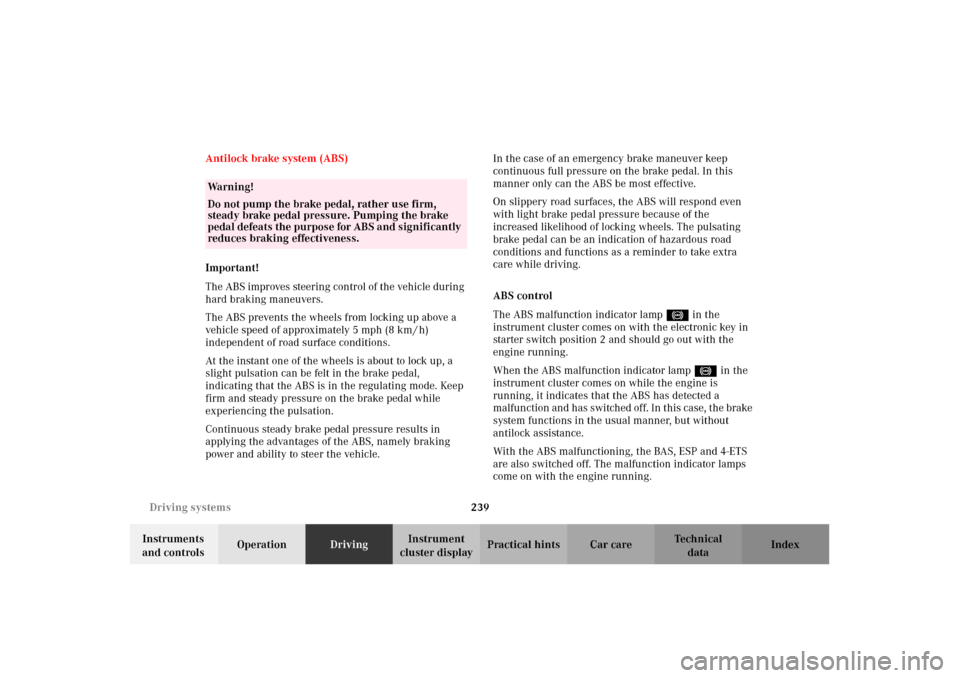
239 Driving systems
Te ch n i c a l
data Instruments
and controlsOperationDrivingInstrument
cluster displayPractical hints Car care Index Antilock brake system (ABS)
Important!
The ABS improves steering control of the vehicle during
hard braking maneuvers.
The ABS prevents the wheels from locking up above a
vehicle speed of approximately 5 mph (8 km / h)
independent of road surface conditions.
At the instant one of the wheels is about to lock up, a
slight pulsation can be felt in the brake pedal,
indicating that the ABS is in the regulating mode. Keep
firm and steady pressure on the brake pedal while
experiencing the pulsation.
Continuous steady brake pedal pressure results in
applying the advantages of the ABS, namely braking
power and ability to steer the vehicle.In the case of an emergency brake maneuver keep
continuous full pressure on the brake pedal. In this
manner only can the ABS be most effective.
On slippery road surfaces, the ABS will respond even
with light brake pedal pressure because of the
increased likelihood of locking wheels. The pulsating
brake pedal can be an indication of hazardous road
conditions and functions as a reminder to take extra
care while driving.
ABS control
The ABS malfunction indicator lamp- in the
instrument cluster comes on with the electronic key in
starter switch position 2 and should go out with the
engine running.
When the ABS malfunction indicator lamp- in the
instrument cluster comes on while the engine is
running, it indicates that the ABS has detected a
malf un ction an d has s witched of f . In t his c ase, t he brake
system functions in the usual manner, but without
antilock assistance.
With the ABS malfunctioning, the BAS, ESP and 4-ETS
are also switched off. The malfunction indicator lamps
come on with the engine running.
Wa r n i n g !
Do not pump the brake pedal, rather use firm,
steady brake pedal pressure. Pumping the brake
pedal defeats the purpose for ABS and significantly
reduces braking effectiveness.
J_G463.book Seite 239 Mittwoch, 19. September 2001 8:06 08
Page 243 of 385

240 Driving systems
Te ch n i c a l
data Instruments
and controlsOperationDrivingInstrument
cluster displayPractical hints Car care Index
The ABS malfunction indicator lamp- also comes
on, when the differential lock is engaged. The ABS is
switched off, but there is no malfunction in the system.
If the charging voltage falls below 10 volts, the
malfunction indicator lamp comes on and the ABS is
switched off. When the voltage is above this value again,
the malfunction indicator lamp should go out and the
ABS is operational.
If the ABS malfunction indicator lamp stays illuminated,
have the system checked at your authorized
Mercedes-Benz Light Truck Center as soon as possible.Notes:
To alert following vehicles to slippery road conditions
you discover, operate your hazard warning flashers as
appropriate.
Operating the vehicle on a single axle dynamometer
should only be done for briefly testing the brakes. To do
so, move selector lever to position “N”. The engine must
be shut off (electronic key in starter switch position 0
or 1).
For ABS malfunction and warning messages, see
page 275.
LOW RANGE – ABS
During off-road driving a special low range system for
the antilock brake system (ABS) is operational with
transfer case in position LOW, see page 247.
An improved braking action (dig in effect) is obtained
for vehicle speeds up to 37 mph (60 km/h) through a
change in the ABS control function.
Wa r n i n g !
ABS cannot prevent the natural laws of physics
from acting on the vehicle, nor can it increase
braking or steering efficiency beyond that afforded
by the condition of the vehicle brakes and tires or
the traction afforded. The ABS cannot prevent
ac c id ent s, i nc l udi ng t hose resul tin g from exc es si ve
speed in turns, following another vehicle too
closely, or aquaplaning. Only a safe, attentive, and
skillful driver can prevent accidents. The
capabilities of an ABS equipped vehicle must never
be exploited in a reckless or dangerous manner
which could jeopardize the user’s safety or the
safety of others.
J_G463.book Seite 240 Mittwoch, 19. September 2001 8:06 08
Page 244 of 385
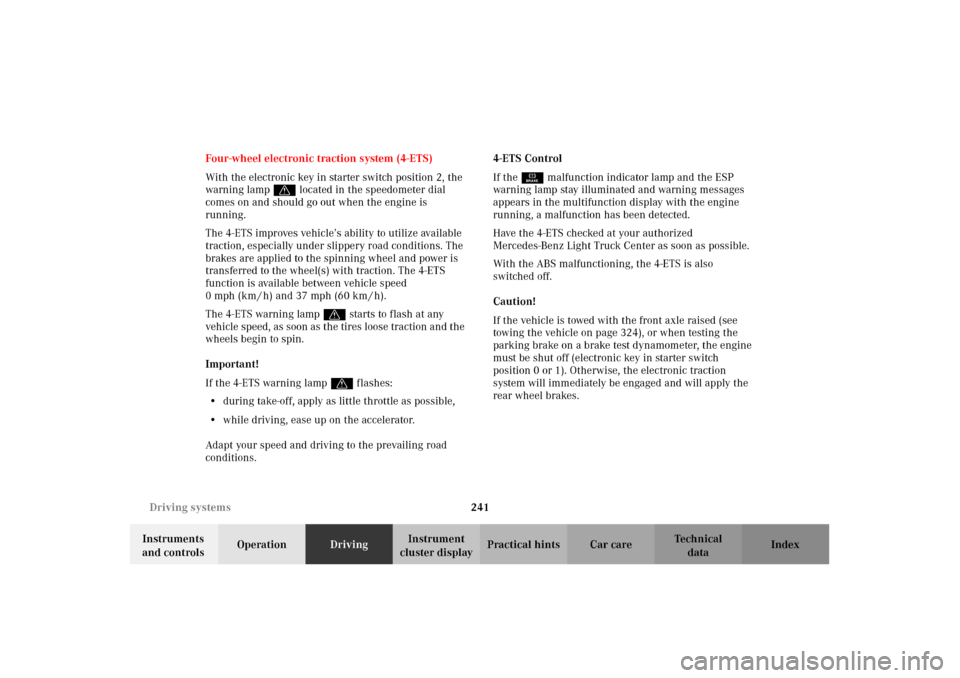
241 Driving systems
Te ch n i c a l
data Instruments
and controlsOperationDrivingInstrument
cluster displayPractical hints Car care Index Four-wheel electronic traction system (4-ETS)
With the electronic key in starter switch position 2, the
warning lampv located in the speedometer dial
comes on and should go out when the engine is
running.
The 4-ETS improves vehicle’s ability to utilize available
traction, especially under slippery road conditions. The
brakes are applied to the spinning wheel and power is
transferred to the wheel(s) with traction. The 4-ETS
function is available between vehicle speed
0 mph (km / h) and 37 mph (60 km / h).
The 4-ETS warning lampv starts to flash at any
vehicle speed, as soon as the tires loose traction and the
wheels begin to spin.
Important!
If the 4-ETS warning lampv flashes:
•during take-off, apply as little throttle as possible,
•while driving, ease up on the accelerator.
Adapt your speed and driving to the prevailing road
conditions.4-ETS Control
If the É malfunction indicator lamp and the ESP
warning lamp stay illuminated and warning messages
appears in the multifunction display with the engine
running, a malfunction has been detected.
Have the 4-ETS checked at your authorized
Mercedes-Benz Light Truck Center as soon as possible.
With the ABS malfunctioning, the 4-ETS is also
switched off.
Caution!
If the vehicle is towed with the front axle raised (see
towing the vehicle on page 324), or when testing the
parking brake on a brake test dynamometer, the engine
must be shut off (electronic key in starter switch
position 0 or 1). Otherwise, the electronic traction
system will immediately be engaged and will apply the
rear wheel brakes.
J_G463.book Seite 241 Mittwoch, 19. September 2001 8:06 08
Page 245 of 385
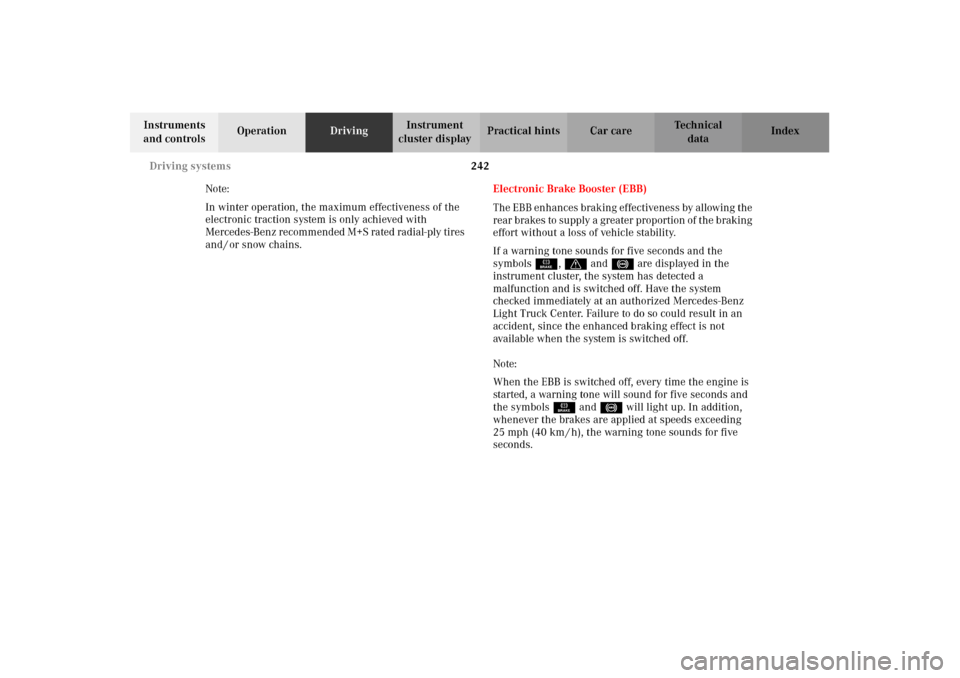
242 Driving systems
Te ch n i c a l
data Instruments
and controlsOperationDrivingInstrument
cluster displayPractical hints Car care Index
Note:
In winter operation, the maximum effectiveness of the
electronic traction system is only achieved with
Mercedes-Benz recommended M+S rated radial-ply tires
and / or snow chains.Electronic Brake Booster (EBB)
The EBB enhances braking effectiveness by allowing the
rear brakes to supply a greater proportion of the braking
effort without a loss of vehicle stability.
If a warning tone sounds for five seconds and the
symbols É, v and - are displayed in the
instrument cluster, the system has detected a
malfunction and is switched off. Have the system
checked immediately at an authorized Mercedes-Benz
Light Truck Center. Failure to do so could result in an
accident, since the enhanced braking effect is not
available when the system is switched off.
Note:
When the EBB is switched off, every time the engine is
started, a warning tone will sound for five seconds and
the symbols É and - will light up. In addition,
whenever the brakes are applied at speeds exceeding
25 mph (40 km / h), the warning tone sounds for five
seconds.
J_G463.book Seite 242 Mittwoch, 19. September 2001 8:06 08
Page 246 of 385
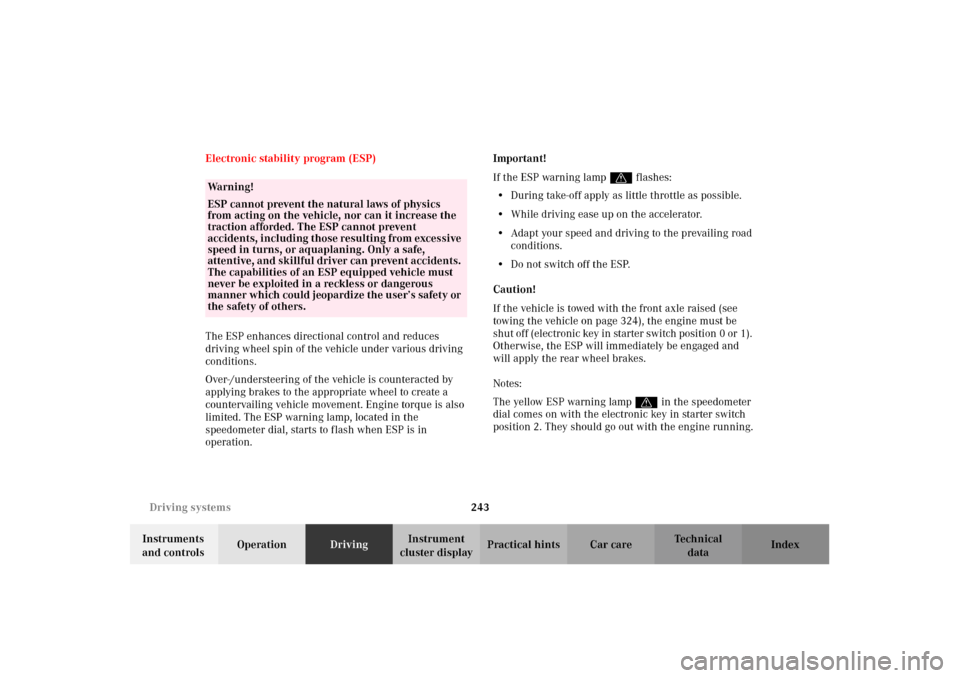
243 Driving systems
Te ch n i c a l
data Instruments
and controlsOperationDrivingInstrument
cluster displayPractical hints Car care Index Electronic stability program (ESP)
The ESP enhances directional control and reduces
driving wheel spin of the vehicle under various driving
conditions.
Over-/understeering of the vehicle is counteracted by
applying brakes to the appropriate wheel to create a
countervailing vehicle movement. Engine torque is also
limited. The ESP warning lamp, located in the
speedometer dial, starts to flash when ESP is in
operation.Important!
If the ESP warning lampv flashes:
•During take-off apply as little throttle as possible.
•While driving ease up on the accelerator.
•Adapt your speed and driving to the prevailing road
conditions.
•Do not switch off the ESP.
Caution!
If the vehicle is towed with the front axle raised (see
towing the vehicle on page 324), the engine must be
shut off (electronic key in starter switch position 0 or 1).
Otherwise, the ESP will immediately be engaged and
will apply the rear wheel brakes.
Notes:
The yellow ESP warning lampv in the speedometer
dial comes on with the electronic key in starter switch
position 2. They should go out with the engine running.
Wa r n i n g !
ESP cannot prevent the natural laws of physics
from acting on the vehicle, nor can it increase the
traction afforded. The ESP cannot prevent
ac c id ent s, i nc l udi ng t hose resul tin g from exc es si ve
speed in turns, or aquaplaning. Only a safe,
attentive, and skillful driver can prevent accidents.
The capabilities of an ESP equipped vehicle must
never be exploited in a reckless or dangerous
manner which could jeopardize the user’s safety or
the safety of others.
J_G463.book Seite 243 Mittwoch, 19. September 2001 8:06 08